About Payam Factory


In accordance with the commands of our supreme leader and name of the year of 2017-18 ( resistance economy, production, and employment), opening of the first car multimedia system factory in Iran ,by Dekade Jahani and Ghaem Pershan group, was held with the presence of a number of national and regional officials, a group of press and media correspondence.
The first phase car multimedia system factory, located in Karaj, Mehrshahr, Payam Airport Economic Zone, has started its activity with the capacity of producing 500,000 multimedia system annually and recruiting around 200 young educated human resources and investing 5,500,000 $ to establish the factory and as the circulation capital.
Ghaem Pershan Arman Company, has started its activity in the field of producing car multimedia system since 2006. In the early stages, the required amount of multimedia system for the domestic car companies were imported and supplied. After 4 to 5 years of gaining experience and knowledge in this field, decisions were made so that the product be imported as semi knock down (SKD) and the assembling process be done in the Eshtehard automotive accessories manufacturing factory, located in Eshtehard. After several years producing the products this way, the managers came up with a new decision to import the product in the complete knock down (CKD) form and produce the multimedia systems in the factory.
From 2015 market research upon various parts of the product, including LCD, ICs, main boards and etc. initiated. During that period of time, Studies were done precisely regarding the devices and equipment required for the production line. After one year of studying and doing research in this field, from 2016, the design and production process of a company was triggered in Payam Airport Economic Zone. The multimedia system production began officially in 2017. After the finishing the construction of the factory and supplyment of all the required accessories for production of the car the multimedia system.
The multimedia system production
The production process consist of distinct stages each of which are done in a separate section. The most important sections are as follows:
SMT section
In the field of production of electronic equipment, the main and the most important part is considered the main board. Thus, in order to produce the main boards domestically, the SMT section has been launched. SMT is the technology of assembling the SMD components. The components on the board are picked up and the smaller components replace them on the board. For instance, with this technology, the all the electronic devices in the market such as TVs, cellphones and tec. Have become smaller and thinner.
SMT technology line consists of three main parts:
1-Printer
2-Pick & Place
3-Oven

Printer
By using this device, the required tin will be printed on the board. It is noteworthy that the device has the inspection ability, which is the ability to inspect itself to see whether the thickness of the tin is the same and it has a uniform distribution in all the areas of the main board. Futhrthurmore, for mass production, for instance production of 1000 main boards, the device examines that the tin distribution in the 1000th board is the same as its distribution in the first one. The device accuracy is in micron size (10 to -6 meters).
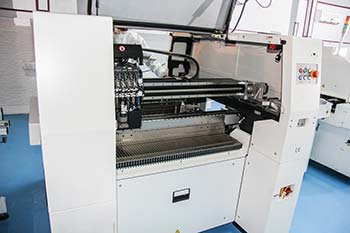
Pick & place machine
This machine has one arm. There are 6 nozzles on top of its arm which makes the device be able to picks and places 6 components from both side simultaneously. The speed of this machine is 28 thousands components per hour. Each nozzle has a camera and they examine all the stages such as picking the components and whether they are flat or not.
Moreover, the fixed camera in the machine is able to examine the feeders from different aspects such as being charged, their correctness, moving forward and correctness of placing the components, all these items are examined by the machine automatically. Thus, the machine is quite intelligent and flexible. Moreover, the machine has the ability to assemble the components from the size 0201 and higher.

Oven machine
After the components being placed on the tin, they are required to be fixed in their specific locations. This process is done by the Oven machine. Its function is similar to that of the microwaves and fixes the components on the tin.
This machine is able to produce any electronic board based on the drawings it is given. The boards used in the automobiles are usually four layered and double sided.
Among the elements assembling on the electronic board, there are always a number of components that cannot be assembled by the SMT technology. These larger components are called DIP and there are assembled in the DIP section of the factory.
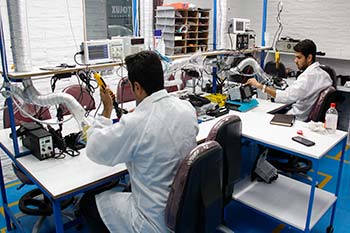
Dip section
The next section is Dip assembly section. In this section all the remaining components are assembled mechanically and the electronic board is finalizes at this stage. In the end, in the Dip section a unit is embedded to run a final test on the boards to make sure they function properly. If no particular defection is observed, the electronic board will be entered the production line.
The assembly and production section
The produced boards in the SMT section will be brought to the assembly site. The assembly process will be done mechanically and depending on the product, the activities done at each station will differ. Usually, the production process is as follow: at first, the main board is attached to the lower part metal. And then the right and the left metals as well as the back metal are connected to the system by particular screws. In the next station of the production line the DVD mechanism and the upper metal are connected. In The next stage, LCD and the case panel are connected by flats. The production process will be finalized by brackets assembly on the system,

Stages of product quality control in the factory production line
QC unit
All products are imported into the QC unit. This unit contains various stations.
First station QC: GPS and radio test
In the first quality control station, the GPS antenna is investigated as well as the Navigation system available on the company's multimedia production system, it simulates the movement path. At this station, the radio is also tested by a special radio test device. So the frequency on the device is adjusted by the frequency of the desired multimedia system and then the desired frequency waves are checked. It also allows you to check the sound output in 4 bands.
The second to fourth QC station: Driver Test
In the next three stations, considering the importance of the device driver, a driver test with at least 2 CDs and DVDs is carefully examined. Other things to consider: reading a music memory card (SD music) and executing the next or previous files in three ways (Touch buttons, panel buttons and volume buttons).
Fifth station: USB test and command control
At this station, files are first processed from USB Then the control unit buttons are set up with the multimedia device buttons
Sixth station: Bluetooth test
At the end of the line, after reviewing the Bluetooth device which includes the ability to make a Bluetooth connection and also the correctness of the microphone function of the device, the quality control steps are completed.
In all quality control stations, Keystone and ACC testing and resetting the machine, Also, the appearance of the product, including the absence of scratches and the accuracy of the screws are examined.

Longevity room
After completing the quality control steps all products to check actual performance they will enter this unit for a long time. In this unit, the products stay on in the current mode from 4 to 8 hour. When a multimedia vehicle system is on, usually it is about 0.7 amps. But when the device is connected to four turned on speakers and the sound turns up, this amount range varies from 5 to 6 amps. For this purpose, components are used to test and simulate the speakers pull out more current and increase the temperature of the device, All the devices in this unit are carefully monitored all the time and in the absence of a problem enter the packaging unit In this unit, bar codes and labels are installed on the product and the product is packaged with its accessories (manual, warranty card, educational card, SD card, wiring harness, etc.).
Simulation tests section
Since we guarantee our products, the other section in the factory is the simulation tests section. The simulation tests are run as follow: random samples from products are separated from the production line and are brought to this section. This section is equipped with the most modern and updated test machines and all the tests run based on the international or national standards. After running the tests on the sample products, all the quality control processes are done on the samples again.
The most significant tests are as follow:
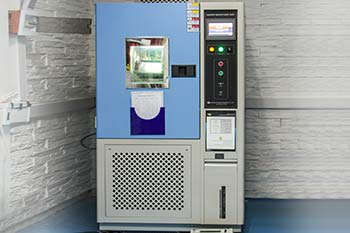
High Temperature & Humidity chamber
In this test the effects of temperature and humidity on the appearance and the function of the products are examined. To do so, the sample is turned on and put in the test chamber. The test condition including temperature and humidity are regulated based on the required standards and / or the requisite of the buyer of the product. The duration of this test is usually 8 hours. The temperature changes per unit time inside the chamber is similar or even tighter than the condition the product might experience in a hot and humid climate condition. During the test, the product will be examined and all the changes in the appearance and the function of the product will be observed and recorded precisely.
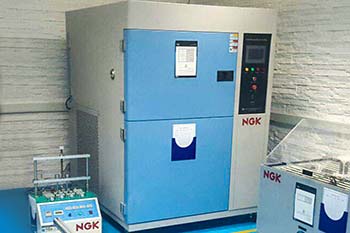
Thermal Shock Test
The temperature effects on the product function is considered noticeable. When this factor is combined with time as another factor, its significance doubles. Which means temperature changes in a short time, is of paramount importance since it might influences on the system's function. The conditions in a real life is similar to those of the thermal shock test. For instance, when the system is installed in a car which is in a hot climate condition and the car's cooling system is used, the product is subject to thermal shock. Hence, continuous cycles of thermal shocks in high and low ranges of temperature are applied to the product. When the test is over, quality control processes are done on the sample products.

Dust testing
In order to test the probability of dust penetration into the product and its influences on the product's function, random product samples are placed in the dust testing chamber.
In Ghaem Pershan laboratory, a developed and modern test device is used which simulates the dust conditions. After the test duration is done based on the intended standards, quality control processes are done on the sample products.

Salt spray test
In order to examine corrosion of metal surfaces in case the product subjects to the humid climate condition, this test is run. In this test sodium chloride solution 95% is used and the results are presented as the percentage of corrosion level. The duration of this test varies between 24 to 240 hours.
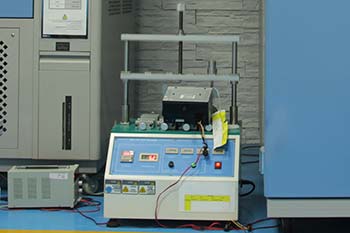
Key life test
Considering the two years warranty of the product, it is necessary to examine the parts of the device that are used more than others such as buttons. To do so, a developed key life test is used. The device mechanism is similar to a piston cylinder mechanism. And the number of the repetition of pressing the buttons will be selected between 20 to 50 thousands depending on the type of the button.
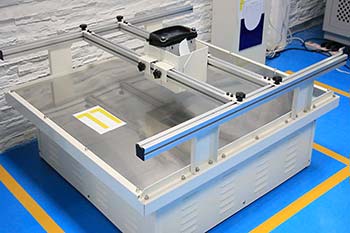
Vibration test
Mechanical vibrations might cause damages to the product, thus, by simulation of the vibration the effects can be evaluated. in order to do that, the sample will be fixed among the holders on the vibration test machine desk and by calculating and selecting the intended frequency depending on the standard type and the selected reference for the test, the vibrations are applied to the product in three directions of the axes x, y and z. when the test is done, quality control processes are done on the sample products.

Electrostatics gain test
In order to test the resistance of the LCD of thee product against static electricity that might be transferred from our body to the product in particular situations, Electrostatics test is run. In order to run this test, electric shock is applied to the LCD of the device and the probability of the damages will be examined.
Company Development Perspective:
According to the Supreme Leader's orders In order to support Iranian goods and domestic production as well as the requirement for domestic car manufacturers to enter into new contracts and taking into account the capabilities of this production complex the possibility of increasing production and development of products in the near future is possible.
Human recourse development:
Since the company has always paid special attention to human resources and considers it a set of capital intends to expand this capital and attract more specialist staff. At the present time, 200 people are active in this company in the perspective drawn for the company; the possibility of increasing troops to 600 staff also exists
Infrastructures development
By increasing the company's human resources, it is possible to increase production capacity and this company will be able to supply the domestic market to a great extent and more importantly, preventing foreign currency departures from the country. The provided explanations are related to the first phase.
In the second phase, the management team decided to establish a three-story factory with a total area of about 3,000 square meters
In the export field
This company is the first automotive video and audio production factory in the middle east, for this reason, it can cover all neighboring countries, because we are closer to them and there is the possibility of fast delivery of products and services. For example, some of the company's products have been exported to Georgia and there are correspondence with the countries of Turkey, Romania and Iraq for export.




